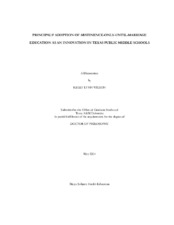| dc.description.abstract | This study assessed indicators of adoption of abstinence-only-until-marriage education as an innovation by middle school principals in the state of Texas. It also assessed school principals?? likelihood of adopting such programs. This study was conducted in the context of changing school policies related to sexuality education and an influx of governmental funding intended to encourage instruction about abstinence-only-until-marriage. The impact of school-based, abstinence education and the role of the principal are of special interest for those promoting healthy sexual behavior among youth. The study??s sample consisted of 433 responses from a proportional random sample of middle school principals selected from 20 Education Service Center Regions in the state of Texas. Rogers?? Diffusion of Innovations Theory provided the theoretical framework and foundation for this research. Five perceived attributions of an innovation??relative advantage, compatibility, complexity, trialability and observability??were the study??s independent variables. The dependent variable was defined as the likelihood of principals adopting abstinence-only-until-marriage education in their schools. Location of schools (i.e., in rural or urban counties), was examined as having a possible moderating effect on other variables. Findings from this study indicated the middle school principal who was most willing to adopt abstinence-only-until-marriage education programs into his or her school??s curriculum strongly believed abstinence education provided important advantages for youth, and strongly perceived abstinence-only-until-marriage education to be consistent with his or her professional and personal beliefs and values. The average principal also did not perceive abstinence-only-until-marriage education to be complex. The typical respondent agreed that elements of abstinence-only-until-marriage education could be easily tried in the school, and considered it important to observe other principals adopting abstinence-only-until-marriage education prior to adopting the innovation. Trialability, complexity and religion were the strongest predictors for likelihood of adoption. Efforts to promote abstinence-only-until-marriage education in the public schools are dependent upon an understanding of the role of administrators in the curriculum adoption process. This study contributes to the knowledge base related to the school principal??s influence on abstinence promoting programs. | en |


